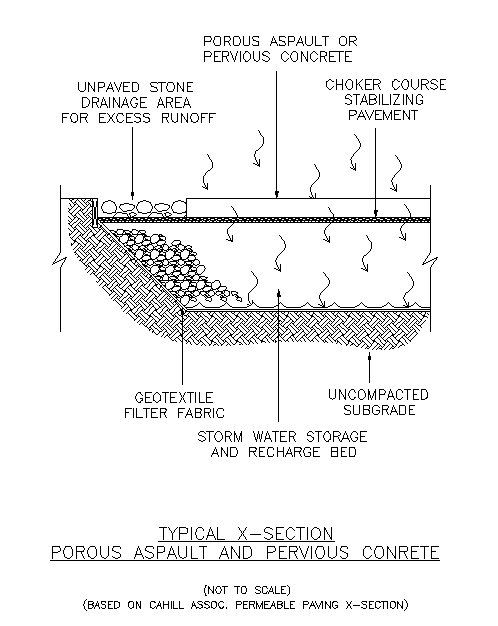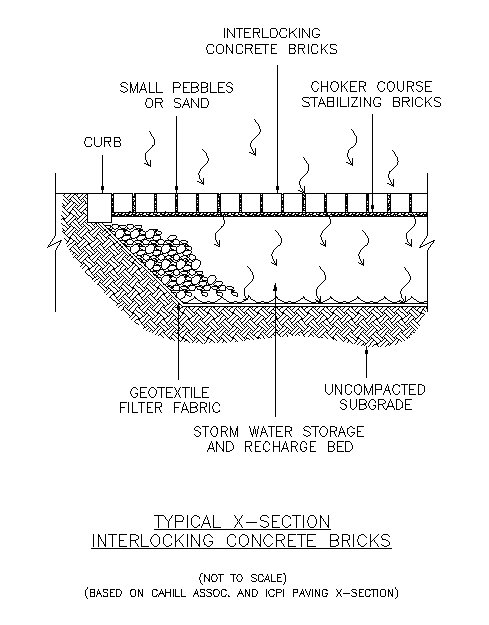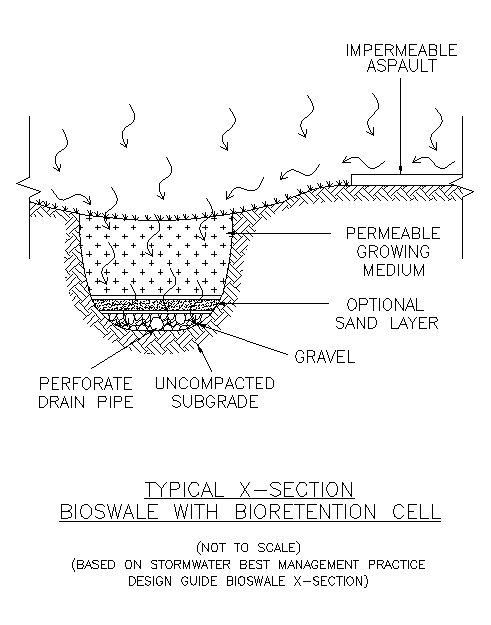So I am trying to figure out my thesis statement, I know we went over it in class but anymore suggestions would be greatly appreciated.
What is the best system for removing pollutants, collected on impevious surfaces, from stormwater runoff?
OR
What is the best system for removin pollutant from stormwater runoff?
I am stuck between these two because my topic is specific to impervious surfaces but I am not sure how well that flows or sounds.
(if any one is unsure, impervious means that water can't filter through it)
Thanks!
Sunday, March 29, 2009
Tuesday, March 24, 2009
ABSTRACT OUTLINE
The carbon footprint that conventional construction is leaving on the earth has become apparent. Green technologies are being studied and developed to help battle some of the impacting sources, such as polluted storm water runoff. This runoff contains contaminants such as foreign soils, metals, phosphorus, and oils. Impervious parking lots are a contributor to this contaminated runoff: they collect pollutants and carry it into our freshwater streams and rivers in the event of precipitation. These pollutants are affecting marine life in various ways, more specifically salmonid (salmon, trout, char, whitefish and graylings). The contaminants are affecting the fish physically, as well as their behaviour, habitat, and spawning grounds.
There are two methods of pollutant removal that are focused on in this report: bioswales and permeable paving. Bioswales are an effective way to remove and break down many of the pollutants found on impermeable parking lot surfaces. Plant matter and infiltration through a soil matrix allows the swale to collect large particles and prevent them from entering into our water. There are biota (bacterial colonies) present within the swale that are able to break down some of the pollutants to a harmless state. Swales can obtain high efficiency rates in pollutant removal and have three different design options: dry, wet, and grassed.
Permeable paving is also a viable source for removing pollutants and has similar pollutant efficiency removal rates to that of a bioswale. Permeable paving allows the storm water to be held in a stone bed comprised of clean stone aggregate where it is allowed to infiltrate slowly into the subsoil below. Biota is used along with fungi to break down the pollutants. The larger particles are then removed from the water by a geotextile fabric filter separating the stone bed from the soil below. Although there are many different forms of permeable paving three methods are examined: pervious concrete, permeable asphalt, and interlocking concrete bricks.
The newly recognized technologies that are designed to purify contaminated runoff make a huge difference in the amount of pollutants reaching streams and rivers. Each of the methods offers a variety of aesthetically pleasing choices which can easily be implemented into future construction, and/or improve impermeable areas.
There are two methods of pollutant removal that are focused on in this report: bioswales and permeable paving. Bioswales are an effective way to remove and break down many of the pollutants found on impermeable parking lot surfaces. Plant matter and infiltration through a soil matrix allows the swale to collect large particles and prevent them from entering into our water. There are biota (bacterial colonies) present within the swale that are able to break down some of the pollutants to a harmless state. Swales can obtain high efficiency rates in pollutant removal and have three different design options: dry, wet, and grassed.
Permeable paving is also a viable source for removing pollutants and has similar pollutant efficiency removal rates to that of a bioswale. Permeable paving allows the storm water to be held in a stone bed comprised of clean stone aggregate where it is allowed to infiltrate slowly into the subsoil below. Biota is used along with fungi to break down the pollutants. The larger particles are then removed from the water by a geotextile fabric filter separating the stone bed from the soil below. Although there are many different forms of permeable paving three methods are examined: pervious concrete, permeable asphalt, and interlocking concrete bricks.
The newly recognized technologies that are designed to purify contaminated runoff make a huge difference in the amount of pollutants reaching streams and rivers. Each of the methods offers a variety of aesthetically pleasing choices which can easily be implemented into future construction, and/or improve impermeable areas.
Tuesday, March 17, 2009
PROJECT OUTLINE REVISED
PROJECT
This analytical report will look at the dirt parking lot on campus, located at the corner of Summit and McGill. The purpose is to compare and contrast the costs and benefits of using bioswales vs. lattice paving as a way to prevent contaminated surface water run off from the lot (if it were to be paved) from entering into the Thompson River.
METHOD
Research Strategy
Interviews Engineering Firms
A More In Depth Research Approach
1) Understand how bioswales work and what they do.
2) Research the different types of bioswales and choose the best one for my chosen site and pollutant removal.
3) Read engineer’s journals for design components and ideas.
4) Look at various cities design manuals to learn the best way to design a bioswale for my site.
5) Find articles describing the types and amount of pollutants entering the runoff from parking lots.
6) Determine if a bioswale is better than using permeable paving. Cost comparison, efficiency comparison, maintenance, life expectancy, impact on the environment.
7) Is the cost, and maintenance of a bioswale in comparison to permeable paving worth the payoff off? How much/type contaminants are removed from entering into our river by using a bioswale vs permeable paving?
SPECIAL PROLEMS
1) What types of plants will be able to survive in Kamloops?
2) How effective are bioswales at removing pollutants vs permeable paving?
3) Is a bioswale more cost effective than a permeable system?
4) How long will a bioswale/permeable paving last for? What type of maintenance is needed?
5) Which type of bioswale will be needed in Kamloops, dry, grass, or wet?
6) Will a bioswale create a place for mosquito to reproduce?
7) How can we prevent a place for mosquitoes to flourish?
8) Will the bioswale/permeable paving freeze in Kamloops?
This analytical report will look at the dirt parking lot on campus, located at the corner of Summit and McGill. The purpose is to compare and contrast the costs and benefits of using bioswales vs. lattice paving as a way to prevent contaminated surface water run off from the lot (if it were to be paved) from entering into the Thompson River.
METHOD
Research Strategy
Interviews Engineering Firms
- Derek Kronebusch (Dayton & Knight Ltd.) – interested
- Scott Bilbrough (Dayton & Knight Ltd.) – possibly interested
- Ashley (Urban Systems) – no reply
- Library books – TRU, Kamloops Library, Vancouver Library
- Library magazines – TRU, Kamloops Library, Vancouver Library
- Engineering journals- resources received from Derek Kronebusch
- Internet – last resort
- Possibly visit sites where bioswales are located
A More In Depth Research Approach
1) Understand how bioswales work and what they do.
2) Research the different types of bioswales and choose the best one for my chosen site and pollutant removal.
3) Read engineer’s journals for design components and ideas.
4) Look at various cities design manuals to learn the best way to design a bioswale for my site.
5) Find articles describing the types and amount of pollutants entering the runoff from parking lots.
6) Determine if a bioswale is better than using permeable paving. Cost comparison, efficiency comparison, maintenance, life expectancy, impact on the environment.
7) Is the cost, and maintenance of a bioswale in comparison to permeable paving worth the payoff off? How much/type contaminants are removed from entering into our river by using a bioswale vs permeable paving?
SPECIAL PROLEMS
1) What types of plants will be able to survive in Kamloops?
2) How effective are bioswales at removing pollutants vs permeable paving?
3) Is a bioswale more cost effective than a permeable system?
4) How long will a bioswale/permeable paving last for? What type of maintenance is needed?
5) Which type of bioswale will be needed in Kamloops, dry, grass, or wet?
6) Will a bioswale create a place for mosquito to reproduce?
7) How can we prevent a place for mosquitoes to flourish?
8) Will the bioswale/permeable paving freeze in Kamloops?
Subscribe to:
Comments (Atom)





